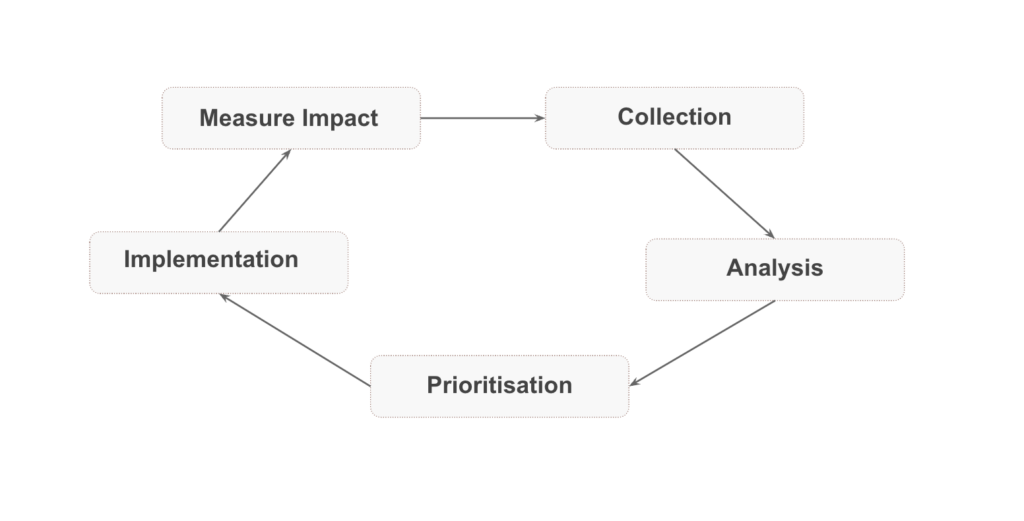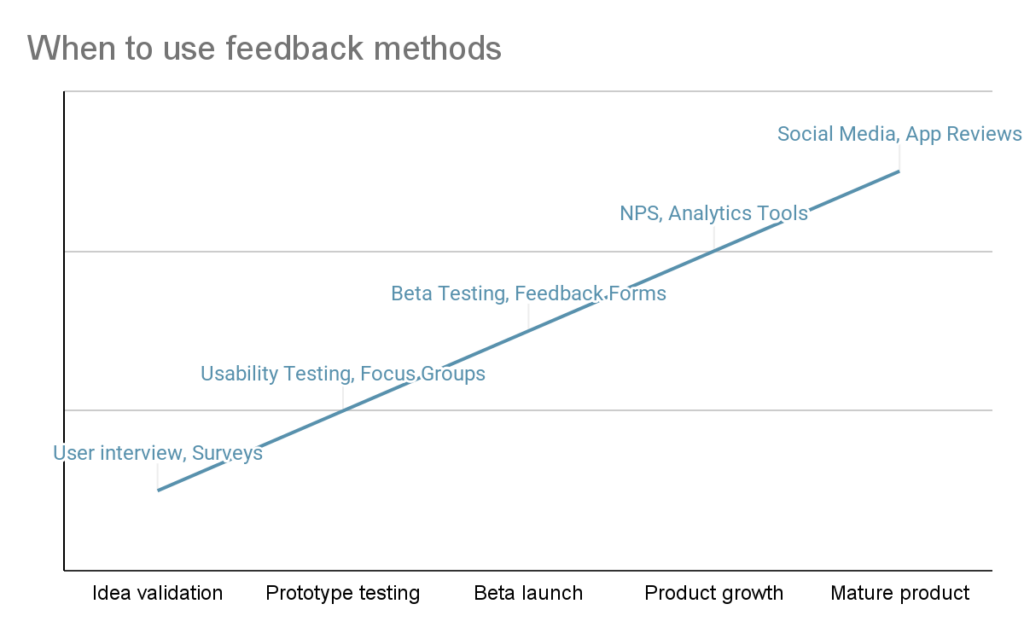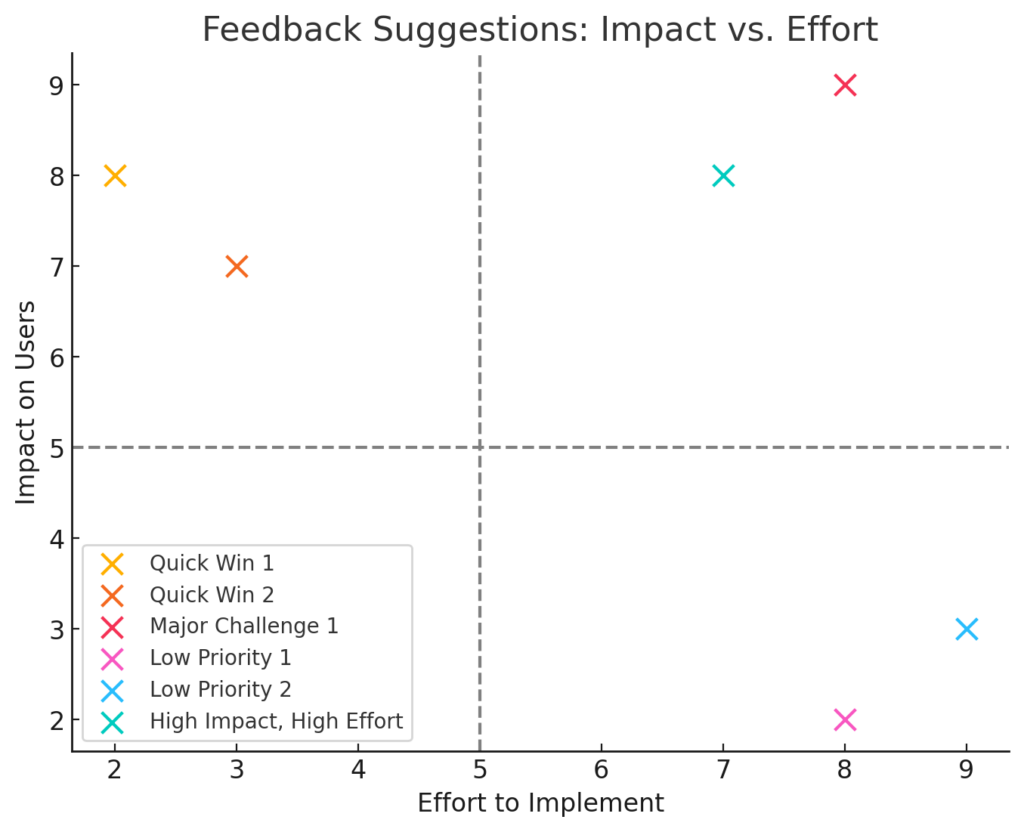User feedback goes beyond understanding how well a product meets certain expectations. In fact, it is the pulse of every business. According to the Impact of AI on Product Research: 2024 Report, 97.7% of industry professionals take user feedback into consideration while developing new products. This statistic goes on to prove that the best information and product insights come directly from the product users themselves. Their feedback, be it in the form of praising a feature or pointing out a flaw, serves as valuable guidance for shaping future innovations.
However, as important as it is to gather user feedback, the true challenge lies in interpreting that information. Feedback is not a block of uniform data. Rather, it’s a collection of various pieces that span across multiple channels that all need to be sorted through and interpreted. But collecting feedback is only the beginning. The real value lies in how effectively teams process, analyze, and act on it. Mismanaged feedback can overwhelm and derail priorities, while a systematic approach can drive continuous improvement, innovation, and user loyalty. In this article, we’ll explore best practices for gathering, categorizing, and leveraging user feedback, turning raw input into a powerful tool for growth.
The twist here is that most negative reviews stem from people wanting to complain about an experience or wishing to warn others about a bad situation. As for the positive reviews, those tend to be left aside a lot more. Lets face it, if everything is going fine customers would not bother reviewing the services. This has to be on the balance and is consequently, extremely important for feedback features to be collected in the first place and for processes to analyze and respond to feedback to be complicated.
Flowchart: Feedback collection process

Collecting data is important in improving products based on how users interact with them. Feedback forms, surveys, setting up Net Promoter Score (NPS) systems, and in-app feedback offer ease and efficiency and can be measured over time. There are formal and informal methods.
These are ideal when you need structured, quantifiable, and actionable insights.
Customer experiences and their perspectives can be captured with qualitative information from informal sources as insights are also important in understanding customer needs aside from structured data collection techniques.
When to use different methods:

Termed applied learning: Feedback from users can be collected on a frequent basis, which is essential to remain relevant and competitive in the market. It ensures that the business continues to grow and remain competitive within the industry.
Through these formal approaches, alongside additional considerations, businesses are able to understand user experience which translates to customer satisfaction and business success.
Understanding your active user feedback coverage, also known as feedback coverage, is a vital metric for data collection. For best results, aim for coverage above 5-10%. The higher the percentage of users providing feedback, the deeper the insights you determine. When businesses strive to achieve a higher feedback coverage, the quality of their insights become much more accurate and actionable due to the data being more representative of them. Having a comprehensive feedback loop allows businesses to capture feedback in such a manner that helps them make decisions that suit customer needs, further nurturing the loyalty and satisfaction from customers.
After collecting significant feedback, the next step for businesses is to turn this data into actionable pieces of information. To achieve this goal, efficient analytical approaches need to be applied, taking into consideration the strategic business objectives that are first and foremost. Feedback can be grouped into different categories which help businesses allocate their resources in the most efficient manner.
Rearranging feedback under different themes is the first step towards achieving optimal insights. Businesses can now split the feedback they receive, as reoccurring issues and opportunities for improvement can be pinpointed. The feedback helps inform clear-making decisions where the needs of the users are most sought after.
Qualtrics and AI integrations automate tag and categorize feedback which makes this task easier and boosts productivity. Some broad key categories may include:
By filtering customer feedback in this manner, businesses can identify the most useful ones in order to know where they will focus their efforts and manage to do the subsequent step, which is determining the key concern.
After categorising the feedback, the next step is figuring out what initiatives will maximize value. Knowing how to focus on the right things makes sure that the limited time, budget, or manpower will be used for the efforts that matter most.
There are many ways to solve the question of how to structure objectives and targets using prioritisation methods, getting the needed salvation from low-level ranking challenges, like the RICE framework or Focus vs Effort Matrix.
Impact vs Effort:

This allows for filtering noise from the data received, which ensures a good user experience is provided with minimal effort and maximum resources.
Alignment with business goals whenever user company requests are unsolicited, these requests are further enhanced by a company’s wider strategic goals. As such, constantly evaluate whether the initiative improves the core value proposition or supports other growth goals, such as improving retention metrics or generating less churn. User feedback is very important, but – and this is crucial – it has to be evaluated in the context of the company’s vision.
Let’s say that a company is trying to grow into other markets. In this case, initiatives aimed at improving localization or region specific features may take more precedence from other general requests as they're more specific. Likewise, if cutting churn is critical as well, then putting on features and fixes that foster customer satisfaction and engagement may be prioritized first before other tasks that are lower on the totem pole.
To determine how effective the process of prioritisation was, companies can measure what is called Efficiency on prioritisation, which is defined as the percentage of prioritised items that impacted the business in the way it was expected. High rates of success means there was effective prioritisation, while low rates indicate that additional work has to be done to improve the system. Proper decision making is often assumed to operate at 70-80% success rate. When businesses are able to track this data constantly, they will be able to fine tune their frameworks so that they will be able to deliver on the important needs of the customers.
Merging feedback from the users and actual product transformation is perhaps the most sensitive period that requires scrupulous planning and collaboration across departments. It allows us to meet user expectations and ensure that the product remains of the desired quality.
Incorporation of consumer feedback: Incorporating customer insights during product or service developments increases customer satisfaction and builds loyalty. A case in point is a retail chain that identified long checkout queues as a pain point through NPS surveys. The chain was able to reduce checkout time by 10%, which corresponded to a 5% increase in sales.
Design changes is where the edits are made and where the edits matter too, which is likely to include:
Repeated usability testings allow the problems to be identified in the advanced stages of design creation to make simpler systems which can be operated by broader interfaces.
With any new changes introduced, a strategy of sustained user adoption is best achieved through a well defined rollout plan. Some concepts to consider are:
Machine Learning and AI can significantly improve the analysis of user feedback. Programs such as MonkeyLearn and IBM Watson provide sentiment analysis which automatically classifies feedback as positive, negative, or neutral and enables collection of insights at a faster rate. AI driven predictive analytics can also uncover new emerging trends across the provided feedback so that businesses can act upon them before the competition. AI algorithms can analyse customer responses and identify certain patterns to predict future behaviors. AI integrated feedback systems can drive retention and customer satisfaction.
A culture of continuous feedback ensures that products always adapt and evolve with user needs. Always-on feedback mechanisms such as in-app surveys or chatbots allow businesses to collect continuous insights without any interruptions. Follow up check-ins can serve to validate any changes made. The findings from Deloitte reported that organizations using AI enabled feedback systems were 39% more effective at retaining talent.
The identification of gaps and areas for improvement is possible through the analysis of benchmarking competition. Feedback from different companies is compared to that from other industry leaders on G2 or Gartner Peer Insights. Customer Sentiment Analysis, Customer Retention Rates, and Feedback Response Times are primary indicators that measure and help keep track of customer satisfaction levels. Integrating AI in the benchmarking process allows companies to understand the business strategies employed by their competition and how their customers perceive them. Through these strategies, companies can improve the overall experience that the user receives.
Managing user feedback is a creative and analytical practice. For most product managers, meshing these two elements is necessary to achieve market competitiveness, satisfaction of users, and business profitability. By employing this approach, along with sophisticated tools and a focus on evidence-based decision making, novice product managers can transform user feedback into innovation and success.
Usability evaluation is not only about listening to users, but about utilizing their insights effectively to achieve strategic aims and give impact. Like Jeff Bezos said, “We’re not competitor obsessed, we’re customer obsessed. We start with what the customer needs and we work backwards.” Let this quote accompany you when trying to achieve proper use of user feedback.








